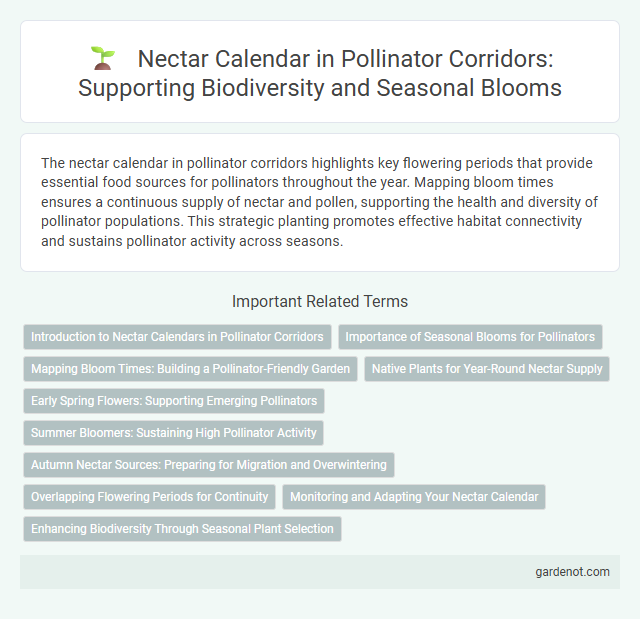The nectar calendar in pollinator corridors highlights key flowering periods that provide essential food sources for pollinators throughout the year. Mapping bloom times ensures a continuous supply of nectar and pollen, supporting the health and diversity of pollinator populations. This strategic planting promotes effective habitat connectivity and sustains pollinator activity across seasons.
Introduction to Nectar Calendars in Pollinator Corridors
Nectar calendars provide detailed schedules of flowering plants within pollinator corridors, highlighting periods of nectar availability critical for sustaining pollinator populations. These calendars map the temporal distribution of nectar sources, ensuring continuous food supply from early spring to late autumn. Implementing nectar calendars supports habitat management by aligning planting strategies with pollinator foraging needs, enhancing biodiversity and ecosystem resilience.
Importance of Seasonal Blooms for Pollinators
Seasonal blooms provide a continuous nectar calendar essential for sustaining pollinators throughout the year. Diverse flowering plants blooming in succession ensure consistent food sources, supporting the health and reproduction of bees, butterflies, and other pollinating insects. This temporal availability of nectar directly influences pollinator population stability and the overall resilience of ecosystems.
Mapping Bloom Times: Building a Pollinator-Friendly Garden
Mapping bloom times through a detailed nectar calendar guides the creation of a pollinator corridor by ensuring continuous floral resources. Plant selection based on peak bloom periods supports diverse pollinator species, enhancing habitat sustainability. This temporal framework maximizes pollination efficiency and biodiversity within the garden ecosystem.
Native Plants for Year-Round Nectar Supply
A well-planned pollinator corridor integrates a nectar calendar that ensures native plants bloom sequentially throughout the year, providing continuous nectar resources essential for pollinators like bees, butterflies, and hummingbirds. Native species such as goldenrod (Solidago spp.) in late summer, milkweed (Asclepias spp.) in spring, and aster (Symphyotrichum spp.) in fall support diverse pollinator populations by bridging nectar gaps. Incorporating a diverse range of flowering periods in ecological restoration enhances habitat connectivity and sustains pollinator health across seasons.
Early Spring Flowers: Supporting Emerging Pollinators
Early spring flowers such as pussy willow, crocus, and snowdrops provide vital nectar sources for emerging pollinators, supporting their energy needs during a critical period. These blossoms bloom from late February to early April, offering a continuous nectar calendar that sustains bees, butterflies, and hoverflies as they awaken from winter dormancy. Establishing a diverse pollinator corridor with early spring blooms enhances pollinator health and promotes ecosystem stability.
Summer Bloomers: Sustaining High Pollinator Activity
Summer bloomers such as milkweed, coneflower, and bee balm play a crucial role in sustaining high pollinator activity by providing abundant nectar sources during peak heat months. These plants ensure continuous food availability for bees, butterflies, and hummingbirds, supporting pollinator health and biodiversity within the pollinator corridor. Incorporating a diverse range of native summer flowering species optimizes the nectar calendar and enhances ecosystem resilience.
Autumn Nectar Sources: Preparing for Migration and Overwintering
Autumn nectar sources are crucial for supporting pollinators during migration and overwintering preparations, providing energy-rich flowers such as goldenrod, asters, and late-blooming sedum. These plants supply essential nectar that sustains bees, butterflies, and hummingbirds as they build fat reserves for long journeys or dormancy periods. Maintaining a diverse autumn nectar calendar enhances pollinator corridor resilience and biodiversity through seasonal transitions.
Overlapping Flowering Periods for Continuity
Overlapping flowering periods within a pollinator corridor ensure a continuous nectar supply from early spring to late fall, supporting diverse pollinator species throughout their active seasons. Strategically selecting native plants with staggered bloom times maximizes foraging opportunities and enhances ecosystem resilience. This continuity in nectar availability is crucial for maintaining pollinator health and promoting biodiversity across the corridor.
Monitoring and Adapting Your Nectar Calendar
Effective monitoring of your nectar calendar involves regularly tracking bloom times and nectar availability to ensure continuous food supply for pollinators. Adjusting planting schedules based on phenological data and climate variability enhances habitat resilience and supports diverse pollinator populations. Utilizing local ecological insights and adaptive management practices optimizes nectar resources throughout the pollinator corridor.
Enhancing Biodiversity Through Seasonal Plant Selection
Strategic selection of flowering plants based on a detailed nectar calendar ensures continuous food availability for pollinators throughout the year, enhancing biodiversity within the corridor. Incorporating native species that bloom in staggered sequences supports diverse pollinator populations by providing nectar and pollen from early spring to late fall. This seasonal plant selection fosters robust ecosystems and promotes pollinator health by maintaining habitat connectivity and resource abundance.
Nectar calendar Infographic

 gardenot.com
gardenot.com